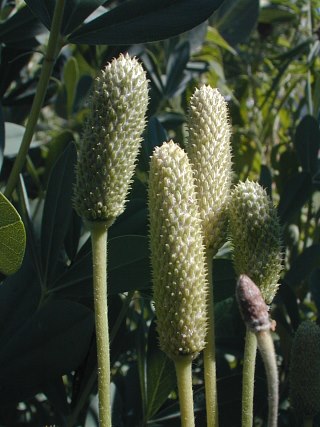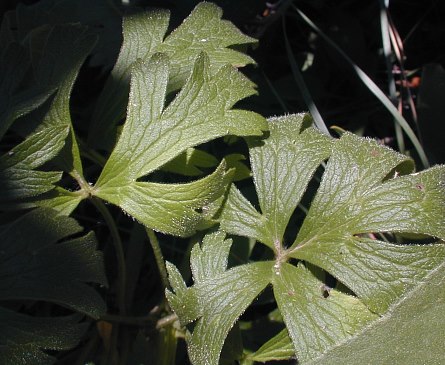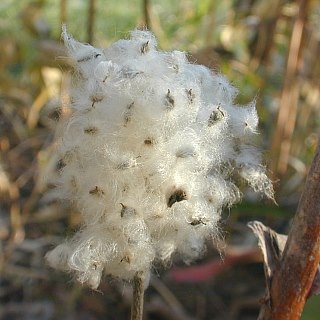Description: This herbaceous perennial plant is about 1-2' tall. The basal leaves occur in whorls from long stalks that emerge out of the ground. They are divided into 3-5 lobes and have dentate margins. From each whorl of the basal leaves often emerges a second whorl of leaves. These secondary leaves are smaller than the basal leaves, but otherwise similar in form. From each whorl of the secondary leaves emerges a long stalk bearing a single white flower. In less mature plants, sometimes the basal leaves produce flowering stalks, rather than whorls of secondary leaves. Sometimes there are small alternate leaves sparsely distributed along the flowering stalks, but they are more narrow and less lobed than the whorled lower leaves. There are scattered white hairs on both the leaves and their stalks. Each flower is about ¾" across, and has 5 petal-like sepals that often fail to open fully. In the center, is a small green cone that is surrounded by numerous stamens with yellow anthers. As the flower withers, the green cone develops into an elongated fruit that resembles a cylindrical green thimble up to 1½" long, hence the name of the plant. This thimble is at least twice as long as it is wide.

The blooming period occurs from early to mid-summer
and lasts about a month. There is no floral scent. The thimble-like
fruits develop during the summer, and then become transformed into
cottony tufts during the fall. These cottony tufts contain scattered
dark seeds and persist during the winter. The seeds are distributed by
the wind. The root system consists of a taproot and tough slender
rhizomes, which can form vegetative offsets. This plant produces an
allelopathic substance, protoanemonin, which inhibits seed germination
and seedling growth of many species of plants.
Cultivation:
The preference is full to partial sun, and mesic to dry conditions in a
rather sandy or gritty soil. In rich fertile soil, this plant has
trouble competing with taller, more aggressive plants. Thimbleweed is
often temperamental about being transplanted and difficult to start
from seed; transplantation should occur during the spring after danger
of hard frost has passed. Established plants, however, are reliable and
easy to deal with. Foliar disease is rarely a problem.

Range &
Habitat:
The native Thimbleweed occurs occasionally in northern Illinois, it is
scattered and
uncommon in central Illinois, and rare or absent in southern Illinois
(see Distribution
Map). Habitats include dry upland areas of black soil
prairies, loess hill prairies, scrubby barrens, limestone glades, sandy
Black Oak savannas, open sandy woodlands, abandoned fields, and open
areas along roadsides. This plant is usually found in less disturbed
habitats.
Faunal Associations:
The abundant pollen of the flowers attract small bees and Syrphid
flies. The bee visitors include Plasterer bees and Halictid bees.
Mammalian herbivores usually avoid consumption of this plant because
the foliage is toxic, causing a burning sensation in the mouth and
irritation of the gastrointestinal tract.

Photographic
Location:
The photographs were taken at the webmaster's wildflower garden in
Urbana, Illinois.
Comments:
This unusual plant has attractive thimble-shaped seedheads that later
look like white tufts of cotton; otherwise, its appearance isn't
particularly showy. Among the native anemones, Thimbleweed has the
greatest fidelity to prairies and the best tolerance of drought (not
including the Pasque Flower). It can be distinguished from other
anemones by the cylindrical seedheads, which are at least twice as long
as they are across. Unlike Anemone canadensis
(Canada Anemone), Thimbleweed's leaves have petioles, whereas the
leaves of the former are sessile. Thimbleweed's leaves differ from Anemone
virginiana (Tall Anemone) by having less dentation along the
margins, and some of its leaves are palmate.